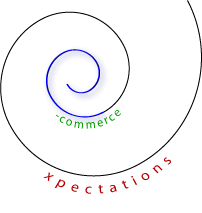The Rise of the Niche Will Transform the Mass Model—The UGM Threat Is the Opportunity
 The advertising industry is at a crossroads. It came of age during the Industrial Economy, and explosive growth coincided with the development of the mass media and the focus on “brand” TV and print advertising. Big media and advertising reflect Industrial Economy values and sensibilities: produce big numbers efficiently and innovate when necessary. Amortize existing investments. The problem is, Knowledge Economy customers want to be communicated with as individuals. Since advertising’s processes have been built with big numbers in mind, they are expensive, and the numbers don’t work when agencies try to address niches. The advertising industry is at a crossroads. It came of age during the Industrial Economy, and explosive growth coincided with the development of the mass media and the focus on “brand” TV and print advertising. Big media and advertising reflect Industrial Economy values and sensibilities: produce big numbers efficiently and innovate when necessary. Amortize existing investments. The problem is, Knowledge Economy customers want to be communicated with as individuals. Since advertising’s processes have been built with big numbers in mind, they are expensive, and the numbers don’t work when agencies try to address niches.
Efficiency in advertising has given rise to a value chain that is as heavy with inflexible infrastructure as the airlines’ hub and spoke system. Advertisers remain focused on “reach,” the number of eyeballs that view their messages (and respond when it’s measurable). That’s how advertising effectiveness is measured. Advertisers are resistant to changing this system, and that makes emerging technologies like mobile video and social networks of secondary interest to them. Meanwhile, innovators are developing technology and offerings to […]
But Legacy Thinking Makes Agency Ecosystem Vulnerable to Disruptive Change—Who Will Be Their Southwest?
 Technology is remaking the advertising business because it is beginning to enable individualized targeting via automated tools. It is not a moment too soon. Technology is remaking the advertising business because it is beginning to enable individualized targeting via automated tools. It is not a moment too soon.
The ultimate context for this session is that technologies are driving interactivity, which is becoming the default for marketing communications. Legacy players in the marcom value chain have mixed feelings: they want to leverage their investments in legacy processes, people and relationships, and many of their clients are not pushing for interactive or its latest incarnation, digital video.
Thought leaders and visionaries are frustrated by their colleagues’ reticence because they perceive that marketers’ worst fear—irrelevance—will soon ensue unless they begin to make serious investments in digital video and Web 2.0, which highlights peer-to-peer interactivity.
When it burst into public view with the growing popularity of the Internet (“Web 1.0”), “interactivity” represented new capabilities and sensibilities. Viewers of marcom messages could react to the messages by clicking, and these clicks could be tracked very economically.
 However, this was merely a brief overture […] However, this was merely a brief overture […]
Pervasive Consumer Connectivity Vision Upstaged by Enterprise Web 2.0 Collaboration
 Cisco’s John Chambers is a master technology marketer who quickens your pulse with technology fire and brimstone. However, as the long-time CEO of Cisco, which epitomized the rise of the (Silicon) Valley when it was briefly the most valuable company in the U.S. in 2000, he has seen the company through the tech bust and proven that he has substance and staying power. Although a hypemeister extraordinaire, he may have crystallized the promise of the Enterprise Web 2.0 better than any other speaker at Digital Hollywood Chicago. Cisco’s John Chambers is a master technology marketer who quickens your pulse with technology fire and brimstone. However, as the long-time CEO of Cisco, which epitomized the rise of the (Silicon) Valley when it was briefly the most valuable company in the U.S. in 2000, he has seen the company through the tech bust and proven that he has substance and staying power. Although a hypemeister extraordinaire, he may have crystallized the promise of the Enterprise Web 2.0 better than any other speaker at Digital Hollywood Chicago.
Chambers’ demos of whiz-bang consumer entertainment scenarios were intriguing but far less interesting to an enterprise-focused audience than his accounts of how Cisco had drastically increased its already-leading efficiency in mergers and acquisitions by collaborating with Web 2.0 tools like wikis. We anticipate that his consumer-focused vision will be consummated far in the future, but his message about enterprise collaboration is achievable this year—for those who are looking for it.
Chambers described an emerging future of networks and communication that revolved around pervasive video, […]
The Internet, E-Business and Web 2.0 in Context
 Web 2.0 and social networks readily appear as hype, but I will argue that they are actors in a much larger drama, the emergence of the Knowledge Economy, which is currently in its third phase, Web 2.0 and social networks. By understanding the transformation of relationships among your customers and between your customers and your company, you will be in a much better position to guide your company through this area of tremendous change. Web 2.0 and social networks readily appear as hype, but I will argue that they are actors in a much larger drama, the emergence of the Knowledge Economy, which is currently in its third phase, Web 2.0 and social networks. By understanding the transformation of relationships among your customers and between your customers and your company, you will be in a much better position to guide your company through this area of tremendous change.
The Ascendance of the Knowledge Economy
The Knowledge Economy is a post-industrial economy in which value is primarily created through information, and differentiation is achieved by explicitly focusing on customer experience itself rather than on products or services. The life cycles of products and services will increasingly shorten. Leaders of companies with products and services who do not understand this face rampant commoditization from which there is no escape except through unprecedented innovation. We are in the third phase of the growth of the Knowledge Economy in which it is transforming relationships. Each phase is ongoing, but the emphasis shifts over […]
In the post-Internet-boom period, it’s easy to forget about some old friends, so here I thought I’d drop in and revisit e-commerce…
 The old joke about commitment being like a ham and eggs breakfast certainly applies to producers (of goods) and consumers in the industrial economy. The punch line is that the chicken (consumer) is involved, but the pig (producer) is committed. The old joke about commitment being like a ham and eggs breakfast certainly applies to producers (of goods) and consumers in the industrial economy. The punch line is that the chicken (consumer) is involved, but the pig (producer) is committed.
A large part of producers’ inflexibility today is due to the fact that they are committed to bits (as opposed to bytes) at all stages of production and distribution: inputs, inventory, safety stocks, unsold goods, returns “… the whole catastrophe,” as Zorba says. These commitments are, in many cases, more important to producers than putting the customer first, and they represent a critical barrier to industrial economy companies’ intimacy with consumers because companies must sacrifice customer needs to maintain their operating realities. (For more on this, see Transformation: from Self-contained Company to Networked Global Organization.)
E-Commerce is steadily liberating producers from this dilemma in many categories. Let’s take a banal example. Probably most readers have shopped at “Earth’s Biggest Bookstore.” For many people, it defined the e-commerce experience. […]
|
|
 The advertising industry is at a crossroads. It came of age during the Industrial Economy, and explosive growth coincided with the development of the mass media and the focus on “brand” TV and print advertising. Big media and advertising reflect Industrial Economy values and sensibilities: produce big numbers efficiently and innovate when necessary. Amortize existing investments. The problem is, Knowledge Economy customers want to be communicated with as individuals. Since advertising’s processes have been built with big numbers in mind, they are expensive, and the numbers don’t work when agencies try to address niches.
The advertising industry is at a crossroads. It came of age during the Industrial Economy, and explosive growth coincided with the development of the mass media and the focus on “brand” TV and print advertising. Big media and advertising reflect Industrial Economy values and sensibilities: produce big numbers efficiently and innovate when necessary. Amortize existing investments. The problem is, Knowledge Economy customers want to be communicated with as individuals. Since advertising’s processes have been built with big numbers in mind, they are expensive, and the numbers don’t work when agencies try to address niches.
 However, this was merely a brief overture […]
However, this was merely a brief overture […] Cisco’s John Chambers is a master technology marketer who quickens your pulse with technology fire and brimstone. However, as the long-time CEO of Cisco, which epitomized the rise of the (Silicon) Valley when it was briefly the most valuable company in the U.S. in 2000, he has seen the company through the tech bust and proven that he has substance and staying power. Although a hypemeister extraordinaire, he may have crystallized the promise of the Enterprise Web 2.0 better than any other speaker at Digital Hollywood Chicago.
Cisco’s John Chambers is a master technology marketer who quickens your pulse with technology fire and brimstone. However, as the long-time CEO of Cisco, which epitomized the rise of the (Silicon) Valley when it was briefly the most valuable company in the U.S. in 2000, he has seen the company through the tech bust and proven that he has substance and staying power. Although a hypemeister extraordinaire, he may have crystallized the promise of the Enterprise Web 2.0 better than any other speaker at Digital Hollywood Chicago. Web 2.0 and social networks readily appear as hype, but I will argue that they are actors in a much larger drama, the emergence of the Knowledge Economy, which is currently in its third phase, Web 2.0 and social networks. By understanding the transformation of relationships among your customers and between your customers and your company, you will be in a much better position to guide your company through this area of tremendous change.
Web 2.0 and social networks readily appear as hype, but I will argue that they are actors in a much larger drama, the emergence of the Knowledge Economy, which is currently in its third phase, Web 2.0 and social networks. By understanding the transformation of relationships among your customers and between your customers and your company, you will be in a much better position to guide your company through this area of tremendous change. The old joke about commitment being like a ham and eggs breakfast certainly applies to producers (of goods) and consumers in the industrial economy. The punch line is that the chicken (consumer) is involved, but the pig (producer) is committed.
The old joke about commitment being like a ham and eggs breakfast certainly applies to producers (of goods) and consumers in the industrial economy. The punch line is that the chicken (consumer) is involved, but the pig (producer) is committed.